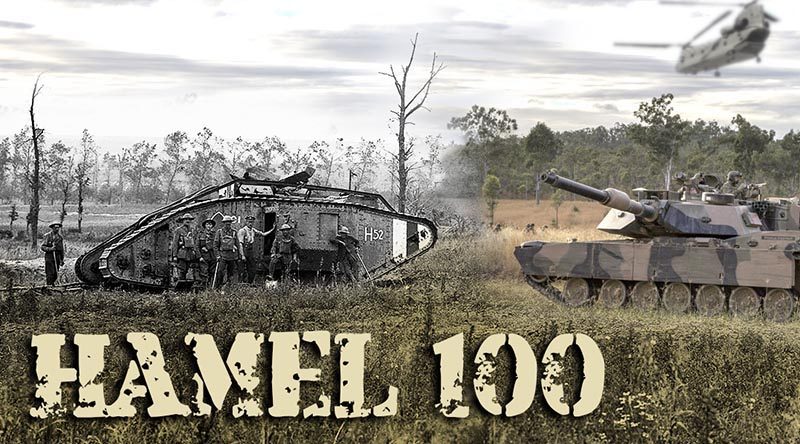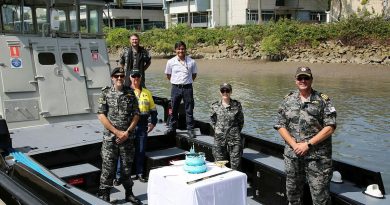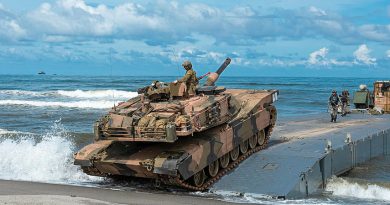Centenary of The Battle of Hamel

One-hundred years ago today, a 93-minute battle was fought during the First World War on the Western Front that is heralded as one of Australia’s greatest military achievements – and is still considered a masterpiece of logistics and combined-arms warfare.
CAPTION: Composite image of WWI British Mk I tank at Le Hamel, France, 4 July 1918 – and a contemporary Australian Army M1A1 Abrams on Exercise Hamel, June 2018.
The Battle of Hamel was a turning point in the First World War.
It was also the first time Australia fought alongside Americans.
Seeking an opportunity to straighten the line north-east of Villers-Bretonneux, in what would be his first battle as Australian Corps commander, Lieutenant General John Monash decided to launch an attack on the Germans at Le Hamel.
Monash meticulously planned the attack, consolidating strategies used in previous battles by the British Expeditionary Force, and coordinated infantry, artillery, armour and aircraft in a way that had not been done before.
The Allies achieved all of their objectives in 93 minutes – just three minutes longer than Monash had planned.
Some 1200 Australians and 170 Americans were killed or wounded – with a relatively small number compared with other battles on the Western Front – while German casualties exceeded 2000 with a further 1600 taken prisoner.
Minister for Veterans’ Affairs Darren Chester will represent the Australian government at a commemorative service in Le Hamel, France, today along with Governor-General Sir Peter Cosgrove and Lady Cosgrove, new Chief of Army Lieutenant General Rick Burr and French Secretary of State under the Minister of the Armed Forces Genevieve Darrieussecq.
Australia’s Federation Guard and members of the Australian Army, including the Australian Army band, will participate in the ceremony at the Australian Corps Memorial in the town of Le Hamel.
“Today marks the centenary of the Battle of Hamel, one in a series of battles after the German Spring Offensive had been halted at nearby Villers-Bretonneux on 25 April 1918,” Mr Chester said.
“Many view the Battle of Hamel as the forerunner of the successful Allied battles leading to the end of the First World War.
“Official War Historian Charles Bean was right when he described Hamel as ‘a big battle on a small scale’ as the methods used – the product of trial and experience – were used on a far grander scale at Amiens on 8 August 1918.
“The Battle of Amiens was a great success and, in just over three hours, Allied troops had overrun the enemy’s front line.
“By the time the battle ended, the Allies had taken more than 29,000 prisoners, more than 330 guns, and had liberated more than 110 towns and villages.
“German General Erich Ludendorff called 8 August ‘the black day of the German army’, but for the Allies it represented a significant victory and further validated the effective tactics used at Hamel.”
Mr Chester said that as the Anzac Centenary 2014-18 period comes close to its end, it was important to remember these critical battles at the end of the First World War, but also to recognise a Century of Service commemorating the service and sacrifice of all Australians killed in wars, conflicts and peacekeeping operations.
The lessons of The Battle of Hamel are still employed today, with combined-arms tactics in full display during last-month’s Exercise Hamel at Shoalwater Bay Training Are in Queensland, where Australian Army, Navy and Air Force teamed with US Marines for large set-piece (mock) battles.
The Centenary of the Battle of Hamel commemorative service will be broadcast live on ABC at 6.00pm AEST on 4 July, as well as on the Department of Veterans’ Affairs Facebook page and YouTube channel.
Following the Battle of Hamel ceremony, Australia’s Federation Guard and the Chief of Army will join Minister Chester at a Headstone rededication for Private Robert Bowness at the Villers-Bretonneux Cemetery.
Private Bowness, from the 4th Pioneer Battalion, was killed by German artillery fire while digging a support trench at Le Hamel on 5 July 1918.
“Today’s rededication will be an opportunity to recognise Private Bowness’ service, and honour his final resting place,” Lieutenant General Burr said.
![]()
.
.
.
.
.
.

.
.





